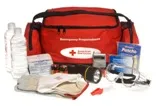Focus on life saving water and medicines
Local officials and relief workers will be on the scene during an emergency, but they cannot reach everyone immediately. In the first days or weeks of a disaster, basic services such as electricity, gas, water, and telephones may be interrupted for days or even weeks. Many of the items listed in various Emergency Kits are for comfort. One of the best ways to determine what you want in your kit is to talk with your loved ones about your plans. Our Earthquake Primers can help with that conversation. Thinking about what you want to do during and after a disaster, is the best way to figure out what you may want to have in your kit(s).
For many in our communities, the cost of putting together an emergency kit can be a barrier. Thankfully, having a kit can be as simple as focusing a few life saving items like water and medicines. People can survive for weeks without food, but only a few days without water. This makes water the key ingredient in preparedness efforts. The regional water providers' website has emergency preparedness resources in 12 languages (with more languages to come).
For Your Home
Home Emergency Kits
A home emergency kit should contain enough items to last for at least 2 weeks. Here are some suggested items for your home emergency kit:
- Water - one gallon per person per day
- Food - a supply of non-perishable food, snacks and a can opener
- NOAA Weather Radio or small personal radio that is hand crank or battery powered
- Flashlight
- Extra batteries
- First aid kit
- Extra prescription medications
- Toiletries and sanitation items
- Tool set that includes tools to turn off your utilities
- Dust mask, gloves, and protective clothing
- Local maps
- Cash in small denominations and quarters for phone calls
- Cell phone with chargers
- Twin buckets for pee and poo
Because putting together an emergency kit for your home can be a daunting task, Multnomah County Emergency Management has put together a
Go Kits
A Go Kit is a portable version of your home emergency kit that you have ready to take with you if you need to evacuate your home. It is a good idea to have one Go Kit per person and have it placed in a location that is easy to access if you have to leave quickly. Below are some suggested items for your Go Kit. Starred items should be included in an adult's kit and may not be necessary for a children's kit.
- Backpack or easy to carry container
- Flashlight
- Radio
- Extra batteries
- Pocket knife*
- Cash in small denominations and quarters for phone calls*
- Change of clothes with sturdy shoes that is weather appropriate
- Local map*
- Portable water (bottled or water packets)
- Non-perishable food or snacks
- Photos of family members and pets for identification
- Family and emergency contact information
- First aid kit including and a list of allergies
- Extra prescription medications
- Copies of identification and health insurance cards
- Toiletries
- Extra house and vehicle keys*
- Activities, games or comfort items for children
For Your Pets
Your pets are important members of your household and they will need an emergency supply kit as well. Here are some suggested items for an emergency kit for your pets as suggested by the Humane Society.
For Your Commute
Whether you are commuting by car, bicycle, bus, train or on foot, it is always a good idea to have a portable emergency kit available. Here are some suggested items for an emergency kit for your commute and a downloadable commuter emergency plan:
Kit for commuting by car
- Car emergency kit including tire chains, jumper cables, flashlight and flares
- Weather appropriate change of clothing and sturdy shoes in case you need to walk
- Bottled water and snacks
- First aid kit
- List of medications and toiletries - toothbrush, toothpaste, deodorant, hand sanitizer
- Map of the local area
- List of alternate travel routes
- Emergency contact information
- Also See ODOT's Winter Travel Information
Kit for commuting by bus, train, bicycle or on foot
- Water and snacks
- First aid items, toiletries, list of medications
- Map of the local area
- List of alternate travel routes and bus or train schedules
- Emergency contact information

